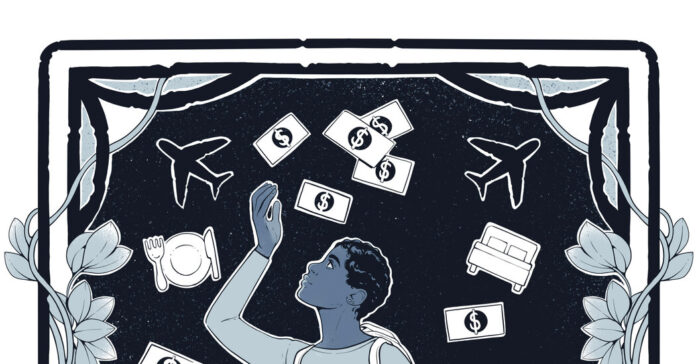Sign-up bonuses, lounge access, cash discounts, free hotel rooms, and tons of fine print: the dizzying promotions and byzantine rules for earning and redeeming points with rewards credit cards can make your head spin. Here are some ways to cut through the confusion and make the most of it.
Rewards cards offer three types of value. Typically, there is a sign-up bonus of up to 120,000 points or miles after spending a minimum amount within a certain period of time. Then there are the points, miles or cash back you get for spending with the card, sometimes multiplied for purchases in specific categories like travel, food or fuel. Finally, there are the benefits you get as a cardholder, like credits toward Global Entry or TSA PreCheck application fees, access to airport lounges, and elite status at hotels.
Travelers should weigh rewards against a card’s annual cost, which can range from zero to $695, and which airlines, hotels and other travel partners it works with. To get the best value, pay off the entire amount each month to avoid interest charges. Autopay is your friend.
Let partnerships work for you
You can gain status with this airline more quickly with a co-branded card like the Alaska Airlines Visa Signature (fee $95). Cards co-branded with airlines may also offer perks like priority boarding, free checked bags, and lounge access—a plus if you tend to fly with one airline. The Alaska Card gives you a companion ticket worth $99 (plus taxes and fees) each year when spending requirements are met. Hotel chains offer similar co-branded cards. The World of Hyatt Visa and Marriott Bonvoy Boundless Visa (both $95) are giving cardholders a free night at their low- to mid-range brands on the anniversary of the customer’s sign-up.
If you choose a non-co-branded card, you can sometimes transfer your points to your preferred airline’s loyalty program. For cards that don’t have partnerships with specific airlines, you can often use code sharing as a workaround. For example, Capital One doesn’t allow you to transfer your points directly to Delta SkyMiles. To book a seat on a Delta flight, transfer your points to Aeromexico — with which Capital One has a partnership — and then use those points to book a codeshare seat on Delta through the SkyTeam alliance.
Stretch points into pennies
Redemption values can change depending on how you use your points, said Gary Leff of travel site View From the Wing. His advice: Explore the various redemption options and try to get at least one cent per point. When purchasing gift cards from various retailers, Citi ThankYou points are usually worth a penny. American Express cardholders earn 1 cent per point when they use their Membership Rewards balance to purchase a plane ticket or hotel room on the Amex website — and some also earn five points per dollar spent. For example, a $500 room booking costs 50,000 points, but purchasing through the website will net you 2,500 points worth $25.
Those same Amex points are only worth about 0.7 cents when used toward a purchase on Amazon and 0.6 cents when used toward eligible purchases on your monthly bill. Credit card websites typically have a section that lists redemption values.
Sometimes points can be worth more than 1 cent when transferred to an airline loyalty program to purchase a ticket, Mr. Leff said. And keep an eye on travel websites, social media and your email inbox for temporary transfer bonus offers that could give you an additional bonus of up to 30 percent on points you spend with a specific airline or airline Hotel partner transferred.
Save money on new cards
Would you like a hefty sign-up bonus? Wait until you’re planning a big vacation, doing a home renovation, or paying college tuition or another big expense, advises Kylie Queisser, who shares travel tips on TikTok. Then use this high spend to meet the minimum spend requirement for the bonus. The Capital One Venture X Visa card ($395) gives you 75,000 miles after spending $4,000 in three months. The Citi AAdvantage Executive World Elite Mastercard ($595) recently offered 100,000 points for spending $10,000 in three months.
Bonus amounts like these can be significant: 75,000 Capital One points can be redeemed for $750 in travel spending; Multiple cross-country airline tickets could be purchased for 100,000 American Airlines miles.
Play to the strengths of each card
If you don’t mind a little juggling, you can maximize utility by tailoring individual cards to specific purchases. For example, combine a Chase Sapphire Reserve card ($550), which gives you three points per dollar on travel and dining expenses, with a no-annual-fee Chase Freedom Unlimited card, which gives you one and a half points per dollar on everything else earn, Mr. Leff suggested. “There are similar ways to link American Express cards and Citibank cards,” he said.
How do you keep track of who is doing what? It’s simple, Mr. Leff said: He puts small stickers with information about restaurants, gas stations, groceries or other categories on each family member’s credit card.

















